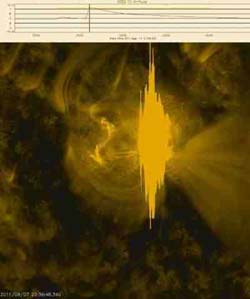Sunspot 1283 bristling with flares: An X1.8 and an M6.7

An X1.8 flare from Sept. 7, 2011, captured here with by the Atmospheric Imaging Assembly (AIA) on the Solar Dynamics Observatory (SDO). Credit: Credit: NASA/SDO/LMSAL/GOES<br>
The third came on September 7 at 6:36 PM ET, and was categorized as an X1.8 by the GOES spacecraft, making it the second X-class flare within 24 hours.
There was a coronal mass ejection (CME) associated with all three of the recent flares, but none of them are expected to travel directly toward Earth, and the first two were unlikely to cause aurora.
NASA computer models suggest that the latest CME may give a glancing blow to Earth on the morning of September 11, and might create some aurora.
The fourth flare from this same sunspot was detected by GOES at 11:36 AM ET on September 8. This was an M6.7 flare, considered moderate.
Media Contact
More Information:
http://www.nasa.govAll latest news from the category: Physics and Astronomy
This area deals with the fundamental laws and building blocks of nature and how they interact, the properties and the behavior of matter, and research into space and time and their structures.
innovations-report provides in-depth reports and articles on subjects such as astrophysics, laser technologies, nuclear, quantum, particle and solid-state physics, nanotechnologies, planetary research and findings (Mars, Venus) and developments related to the Hubble Telescope.
Newest articles

A universal framework for spatial biology
SpatialData is a freely accessible tool to unify and integrate data from different omics technologies accounting for spatial information, which can provide holistic insights into health and disease. Biological processes…

How complex biological processes arise
A $20 million grant from the U.S. National Science Foundation (NSF) will support the establishment and operation of the National Synthesis Center for Emergence in the Molecular and Cellular Sciences (NCEMS) at…

Airborne single-photon lidar system achieves high-resolution 3D imaging
Compact, low-power system opens doors for photon-efficient drone and satellite-based environmental monitoring and mapping. Researchers have developed a compact and lightweight single-photon airborne lidar system that can acquire high-resolution 3D…





















